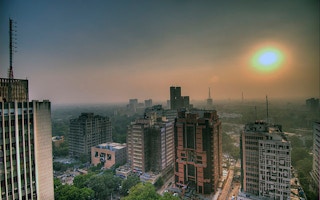Large real-estate developments in India should be subject to the same scrutiny as industrial projects given their environmental impact, according to city planners and campaigners.
A proposal to redevelop parts of New Delhi that required the felling of thousands of trees recently provoked fierce protests, court petitions and night patrols to guard the trees.
While projects measuring more than 20,000 square metres require impact assessments, exemptions are often made and public hearings are never held, analysts said.
“Large construction projects have a huge environmental and social footprint, and deserve scrutiny for their impact on energy and water use, and urban infrastructure,” said Kanchi Kohli at New Delhi think tank Centre for Policy Research.
“Cities are already dealing with severe air pollution, water shortages and traffic congestion. Residents deserve a say in these projects,” she told the Thomson Reuters Foundation.
Worldwide, cities occupy 2 per cent of the land mass, but account for more than 70 per cent of carbon dioxide emissions.
India is forecast to overtake China by 2024 as the world’s most populous country, with tens of millions of citizens cramming into already crowded cities.
“
Large construction projects have a huge environmental and social footprint, and deserve scrutiny for their impact on energy and water use, and urban infrastructure.
Kanchi Kohli, Centre for Policy Research
As developers rush to cash in, unplanned urban sprawl is leading to congestion, flooding and more slums, analysts say.
Authorities have introduced stricter environmental laws for businesses in recent years, but analysts say they are poorly implemented in a rush to lure investors.
But it is not all one way.
Chirayu Bhatt, an urban planner at CEPT University in Ahmedabad, said large developments - be they residential or commercial—can be good for future generations even if today’s city dwellers often pay the price.
“While the costs of a project are borne by current residents, the benefits accrue to future residents—migrants, our children and grandchildren. We must recognise that,” he said.
In New Delhi, the National Green Tribunal - which decides on environmental matters - last week ordered that no trees be felled while the redevelopment case is examined.
Developers say subjecting real estate projects to the same scrutiny as large industrial developments is “not justified”.
“There are already stringent environmental clearances that are required, and measures such as rainwater harvesting and sewage treatment plants have been made mandatory,” said Anuj Puri, chairman of Anarock Property Consultants.
But excluding citizens is not right, Kohli said.
“Citizens must be a part of the review process; more so now, because the drawing of groundwater, the discharge of effluents, the use of public spaces affects us all.”
This story was published with permission from Thomson Reuters Foundation, the charitable arm of Thomson Reuters, that covers humanitarian news, women’s rights, trafficking, property rights, climate change and resilience. Visit news.trust.org to see more stories.

















